Table of Contents
- Introduction
- Editor’s Choice
- Global Frozen Food Market Overview
- Global Frozen Food Trade Statistics
- Top Frozen Food Exporting Countries Statistics
- Top Frozen Food Importing Countries Statistics
- Frozen Food Purchase Preferences
- Frozen Food Channel Choices Statistics
- Frozen Food Buying Preferences During the COVID-19 Pandemic
- Reasons for Buying Frozen Food
- Recent Developments
- Conclusion
- FAQs
Introduction
Frozen Food Statistics: The frozen food industry, a vital segment of the food and beverage sector, offers an extensive range of products like fruits, vegetables, meats, and prepared meals, appealing to consumers seeking convenience and variety.
Market growth is fueled by trends favoring convenience, health consciousness, and product innovation. Key players like Nestlé, Conagra, and General Mills compete fiercely, emphasizing factors such as quality, innovation, and distribution.
Regulatory bodies enforce strict standards to ensure product safety and quality. Despite challenges, the industry is poised for growth, driven by evolving consumer preferences and technological advancements, demanding ongoing attention to health, sustainability, and quality.
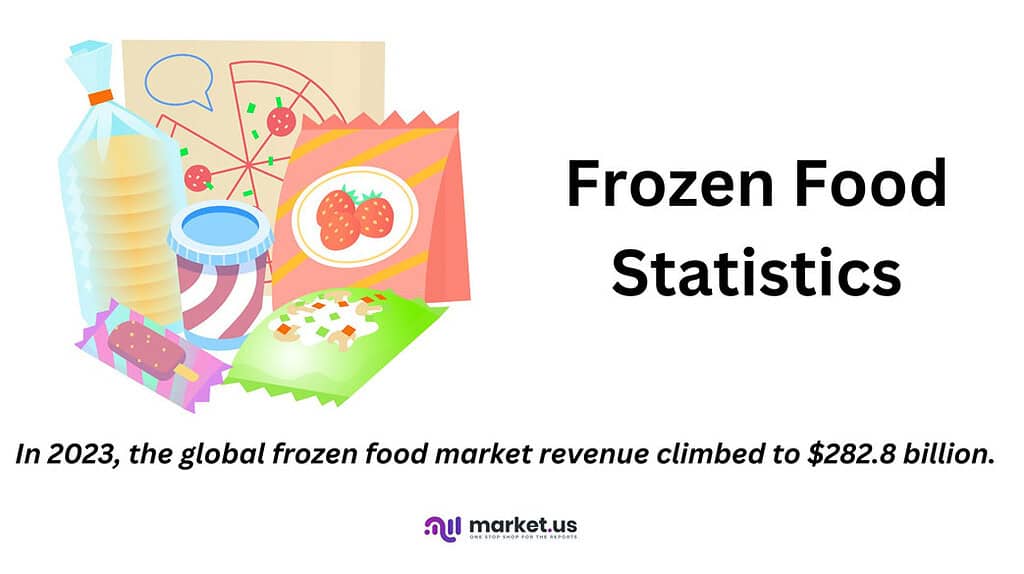
Editor’s Choice
- The global frozen food market has been witnessing steady growth over the past decade, with revenues increasing from 269.1 billion USD in 2022 to 437.1 billion USD in 2032.
- In 2022, ready meals and convenience foods revenue accounted for 118.40 billion USD, followed by potatoes at 26.91 billion USD, and fruits and vegetables at 32.29 billion USD.
- India leads the exporters pack with a substantial volume of shipments, totaling 244,817 units, reflecting its significant presence in the frozen food export sector.
- Topping the importer list is the United States, with a significant volume of shipments totaling 177,394 units, reflecting its vast consumer market and appetite for frozen goods.
- While the majority of frozen food buyers (83%) still regard frozen options as a backup choice, dedicated consumers tend to purchase with specific meals in mind.
- Online sales of frozen foods saw a notable increase in 2020, with 51% of shoppers having bought groceries online and 82% of them purchasing frozen food.
- Several factors emerge as significant influencers When considering why consumers opt for frozen food products. Foremost among these is the convenience offered by frozen meals, with 14% of respondents ranking it as their primary motive.

Global Frozen Food Market Overview
Global Frozen Food Market Size Statistics
- The global frozen food market has been witnessing steady growth over the past decade, with revenues increasing from 269.1 billion USD in 2022 to 437.1 billion USD in 2032.
- This growth trajectory reflects a compound annual growth rate (CAGR) of 5.1%, indicative of the market’s resilience and evolving consumer preferences.
- In 2023, the revenue climbed to 282.8 billion USD, marking a notable uptick from the previous year.
- Subsequent years continued this upward trend, with revenues reaching 295.4 billion USD in 2024 and further escalating to 314.4 billion USD in 2025.
- By 2030, the market surpassed the 393 billion USD mark, indicating substantial expansion.
- Notably, the years ahead forecast continued growth, with projections estimating revenues to soar to 413.2 billion USD by 2031 and 437.1 billion USD by 2032.
- This trajectory underscores the enduring global demand for frozen food products, driven by convenience, extended shelf life, and evolving dietary preferences.
(Source: market.us)
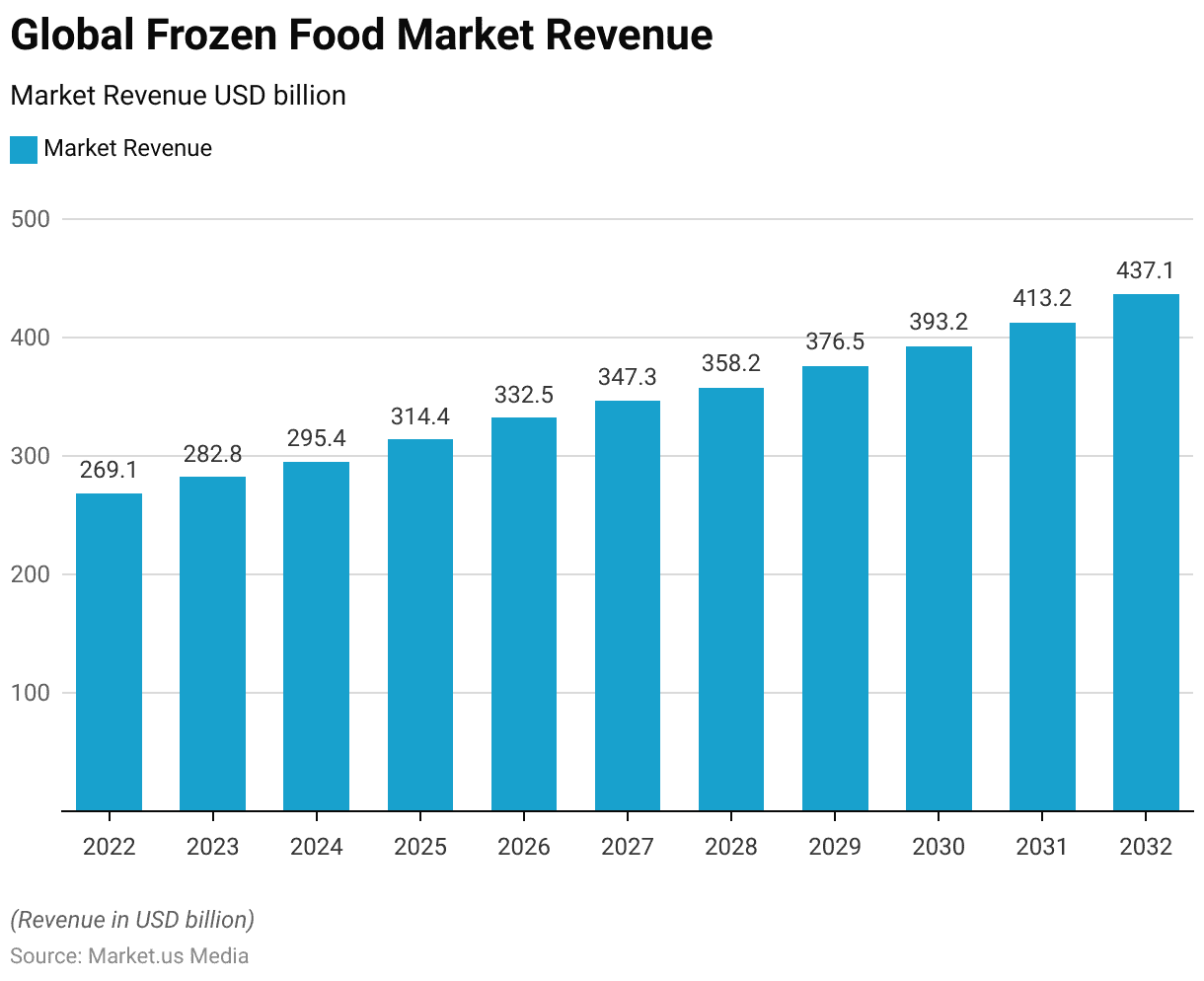
Global Frozen Food Market Size – By Product Statistics
- The global frozen food market has exhibited robust growth across various product categories over the years, reflecting shifting consumer preferences and increasing demand for convenient food options.
- In 2022, the total market revenue stood at 269.1 billion USD, with ready meals and convenience foods accounting for 118.40 billion USD, followed by potatoes at 26.91 billion USD, and fruits and vegetables at 32.29 billion USD.
- Meat products generated revenue of 29.60 billion USD, while fish/seafood products and other frozen products contributed 26.91 billion USD and 34.98 billion USD, respectively.
- Over the subsequent years, the market witnessed consistent expansion, with revenues reaching 437.1 billion USD in 2032.
- Ready meals and convenience foods remained the largest segment, with revenue climbing to 192.32 billion USD, followed by potatoes, fruits and vegetables, meat products, fish/seafood products, and other frozen products.
- This growth underscores the enduring appeal of frozen food across diverse product categories, driven by factors such as convenience, extended shelf life, and evolving dietary preferences worldwide.
(Source: market.us)
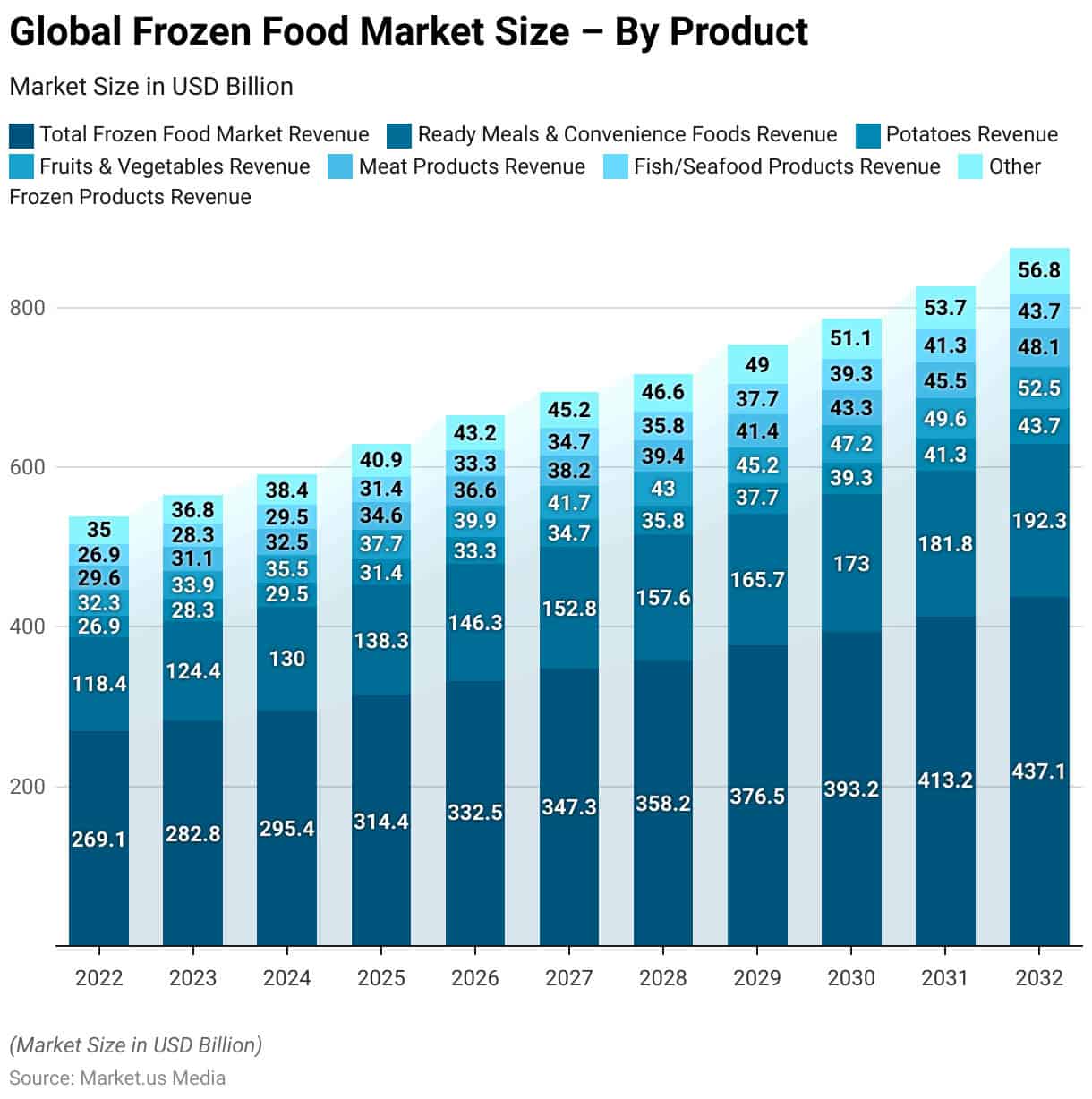
Global Frozen Food Market Share – By Distribution Channel Statistics
- In the distribution landscape of the frozen food market, offline channels dominate with an impressive market share of 88%.
- Traditional brick-and-mortar stores, supermarkets, and specialty frozen food outlets play a pivotal role in catering to consumer demand for frozen products, offering convenience and accessibility.
- However, online channels have been steadily gaining traction, capturing a noteworthy 12% market share.
- E-commerce platforms and online grocery delivery services provide consumers with the convenience of ordering frozen foods from the comfort of their homes, contributing to the overall market growth.
- While offline channels continue to hold the majority share, the rise of online platforms signifies a shifting consumer behavior toward digital convenience. It highlights the importance of omnichannel strategies for industry players to reach and engage consumers effectively.
(Source: market.us)

Global Frozen Food Trade Statistics
- According to Volza’s Global Import data, the worldwide import of frozen food under HSN Code 1905 amounted to 50.7 thousand shipments, facilitated by 691 importers from 443 suppliers.
- The primary sources for these imports are India, Italy, and Pakistan.
- The United States leads as the largest importer, receiving 36,163 shipments, followed by Australia with 4,440 shipments and Canada with 4,403 shipments.
- The top three categories within the frozen food and HSN Code 1905 imports include HSN Code 19059090, HSN Code 19059030, and HSN Code 190590.
- As of December 11, 2023, the information provided is current and derived from Volza’s Global Import Export database, specifically focusing on the import data for frozen food categorized under HSN Code 1905. This data encompasses imports sourced from 70 different countries.
(Source: Volza)
Take advantage of our unbeatable offer - buy now!

Top Frozen Food Exporting Countries Statistics
- The top frozen food exporting countries showcase a diverse range of global contributors to this lucrative market.
- India leads the pack with a substantial volume of shipments, totaling 244,817 units, reflecting its significant presence in the frozen food export sector.
- Following India, the United States stands out with 29,193 shipments, leveraging its advanced food processing infrastructure and quality standards.
- Italy and China also play pivotal roles, with 17,788 and 15,905 shipments, respectively, highlighting their culinary heritage and manufacturing prowess.
- Germany, Spain, and the Netherlands exhibit noteworthy performances with 10,086, 9,194, and 8,712 shipments, respectively, underscoring their position as key exporters.
- Vietnam, Poland, and Austria round out the top ten with impressive figures of 8,661, 7,958, and 7,900 shipments, demonstrating their growing influence in the global frozen food trade.
- This data underscores the dynamic nature of the industry, driven by diverse market forces and consumer preferences across continents.
(Source: Volza)
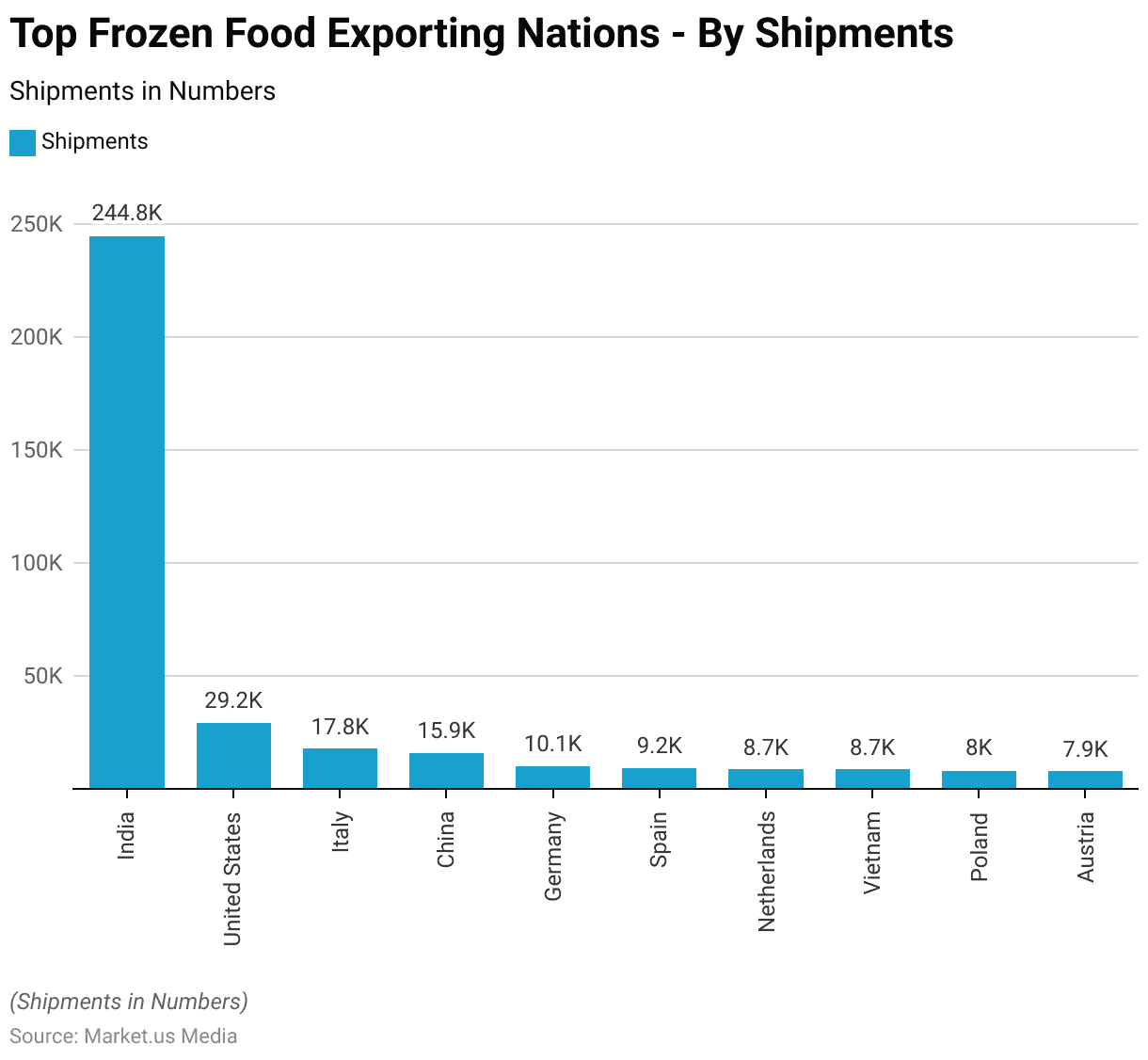
Top Frozen Food Importing Countries Statistics
- The top frozen food importing countries highlight the global demand for convenient and diverse food options.
- Topping the list is the United States, with a significant volume of shipments totaling 177,394 units, reflecting its vast consumer market and appetite for frozen goods.
- Australia and Vietnam follow closely behind, with 35,629 and 28,460 shipments, respectively, underscoring the international reach of the frozen food trade.
- The United Kingdom and the Netherlands also emerge as key importers, with 22,477 and 13,169 shipments, respectively, indicative of their diverse culinary landscapes and consumer preferences.
- Canada, New Zealand, Singapore, and the Philippines demonstrate substantial imports, with figures ranging from 11,467 to 7,527 shipments, highlighting their participation in the global frozen food market.
- Germany rounds out the top ten with 7,217 shipments, emphasizing Europe’s significant role in the importation of frozen food products.
- This data underscores the interconnected nature of the frozen food industry, shaped by consumer demand, trade agreements, and economic factors across borders.
(Source: Volza)
Frozen Food Purchase Preferences
- While the majority of frozen food buyers (83%) still regard frozen options as a backup choice, dedicated consumers tend to purchase with specific meals in mind. Frozen foods are valued for their affordability and the convenience of fewer grocery trips.
- The primary drivers of purchase include easy preparation, quick meal solutions, and time savings, with taste and quality being particularly important to core consumers.
- Preferences for brands vary by product, with national brands slightly preferred (23%) over private labels (17%).
- In 2020, manufacturer brands accounted for 77.1% of dollar sales, experiencing a growth of 16.9% ($7.3 billion), while private labels grew by 22.8% ($2.8 billion).
- The proportion of sales attributed to promotions decreased from 30.2% in 2019 to 23.7% in 2020 due to reduced merchandising during the pandemic.
- Frozen food buyers express interest in more resealable packaging (38%), various pack sizes (31%), and environmentally friendly packaging (28%).
(Source: Firestone Pacific Foods)
Frozen Food Channel Choices Statistics
- In 2020, most frozen food buyers frequent supermarkets and supercenters, but there are significant differences across generations. Club stores, supermarkets, and e-commerce platforms emerged as the primary winners.
- Online sales of frozen foods saw a notable increase, with 51% of shoppers having bought groceries online and 82% of them purchasing frozen food.
- This equates to a rise from 23% to 42% of households buying frozen foods online compared to 2019.
- Online sales of frozen foods surged by 75% in 2020, with frozen dinners/entrees, meat, poultry, and seafood leading the way.
- However, online shoppers may overlook new items, with 7% unsure where to find them and 26% rarely or never browsing for new products.
- To capture their attention, online retailers can utilize sales promotions (52%), coupons (48%), and improved search functions, such as featuring new items at the top (42%) or highlighting new products within the app or website (32%).
(Source: Firestone Pacific Foods)
Frozen Food Buying Preferences During the COVID-19 Pandemic
- In the past three months, compared to pre-pandemic times, there has been an increase in the purchase of frozen foods for several reasons.
- Notably, 47% of consumers cite the ease of preparation, which saves time on cooking and cleaning, as a primary motivator. Similarly, 47% report eating more meals at home, driving the demand for convenient food options.
- Additionally, 43% find that having frozen foods on hand helps minimize trips to the grocery store, aligning with efforts to reduce exposure to public spaces.
- Other factors contributing to the rise in frozen food purchases include the desire to have a backup in case of food shortages (40%), the perceived cost savings (38%), and the availability of a variety of options in-store (24%).
- Furthermore, 22% of consumers appreciate the ability to add variety to their meal lineup, while 21% value the reduction of food waste.
- Despite these increases, some consumers (19%) indicate that they have been using more frozen foods lately, regardless of the pandemic, suggesting a broader shift in consumption habits.
- Moreover, concerns about food safety have led 16% of consumers to view frozen foods as a safer option compared to fresh produce amidst the ongoing uncertainties.
(Source: Firestone Pacific Foods)
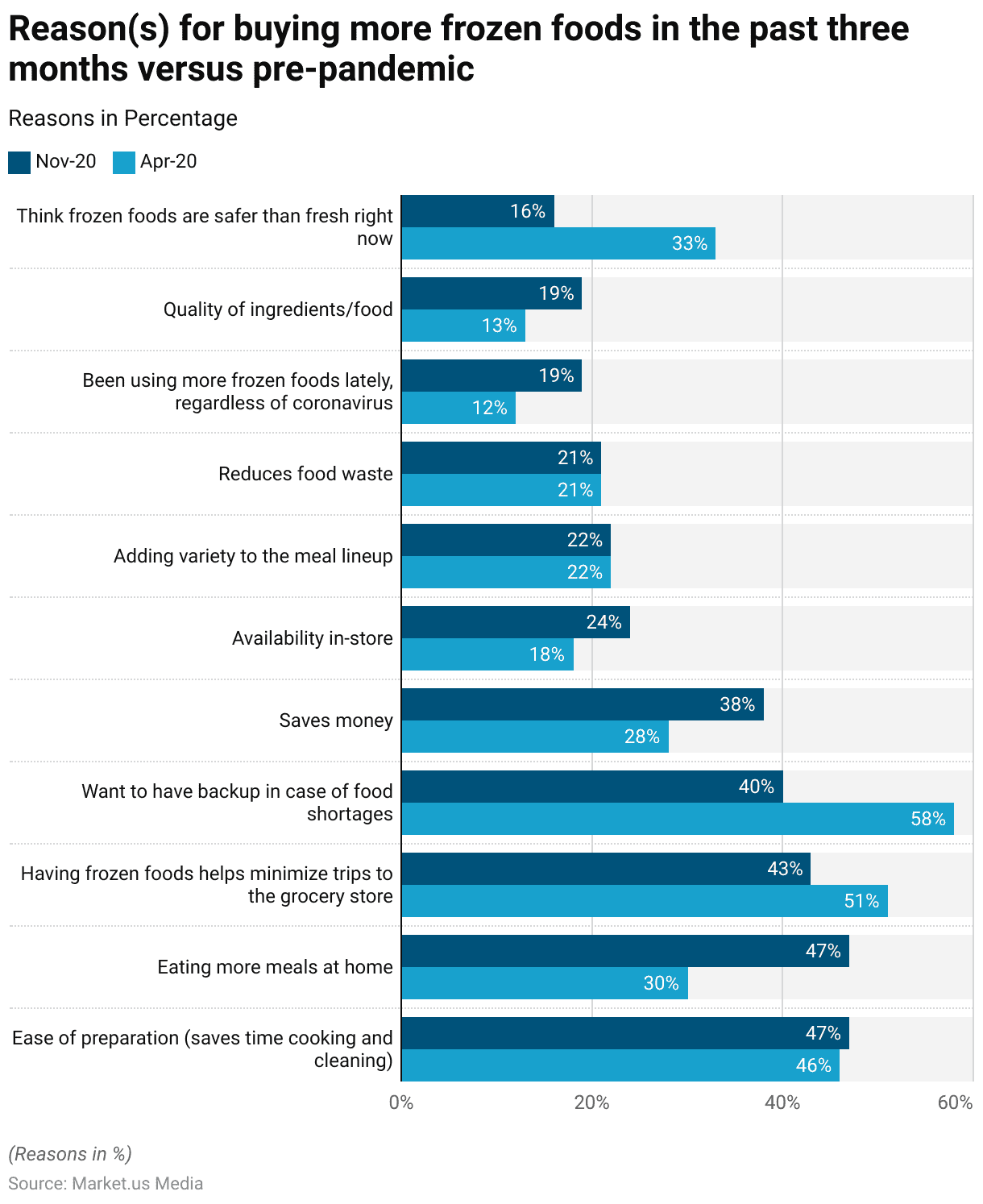
Reasons for Buying Frozen Food
- When considering the reasons consumers opt for frozen food products, several factors emerge as significant influencers. Foremost among these is the convenience offered by frozen meals, with 14% of respondents ranking it as their primary motive.
- This convenience encompasses ease of preparation (13%) and the ability to provide a quick total meal solution (14%), aligning closely with the modern lifestyle’s demand for efficiency and time-saving measures.
- Following closely behind, the aspect of time savings (9%) underscores the appeal of frozen foods in streamlining meal preparation processes, allowing individuals to balance busy schedules without sacrificing nutritional quality.
- Additionally, the longevity of frozen food items (11%) proves essential, addressing concerns about food wastage and ensuring a reliable supply of meal ingredients over time.
- While price (9%) and ease of meal planning (8%) also play significant roles, taste (8%) and variety of options (6%) contribute to enhancing the overall appeal of frozen food products, satisfying consumers’ diverse preferences and culinary interests.
- Moreover, considerations of quality (7%), nutritional value (5%), and product consistency (3%) underscore consumers’ expectations for high standards in their food choices, indicating a growing emphasis on health-consciousness and satisfaction with product performance.
- In essence, the decision to purchase frozen food products is driven by a combination of convenience, longevity, and sensory satisfaction, reflecting a nuanced balance of practicality and culinary enjoyment in modern consumption patterns.
(Source: Firestone Pacific Foods)
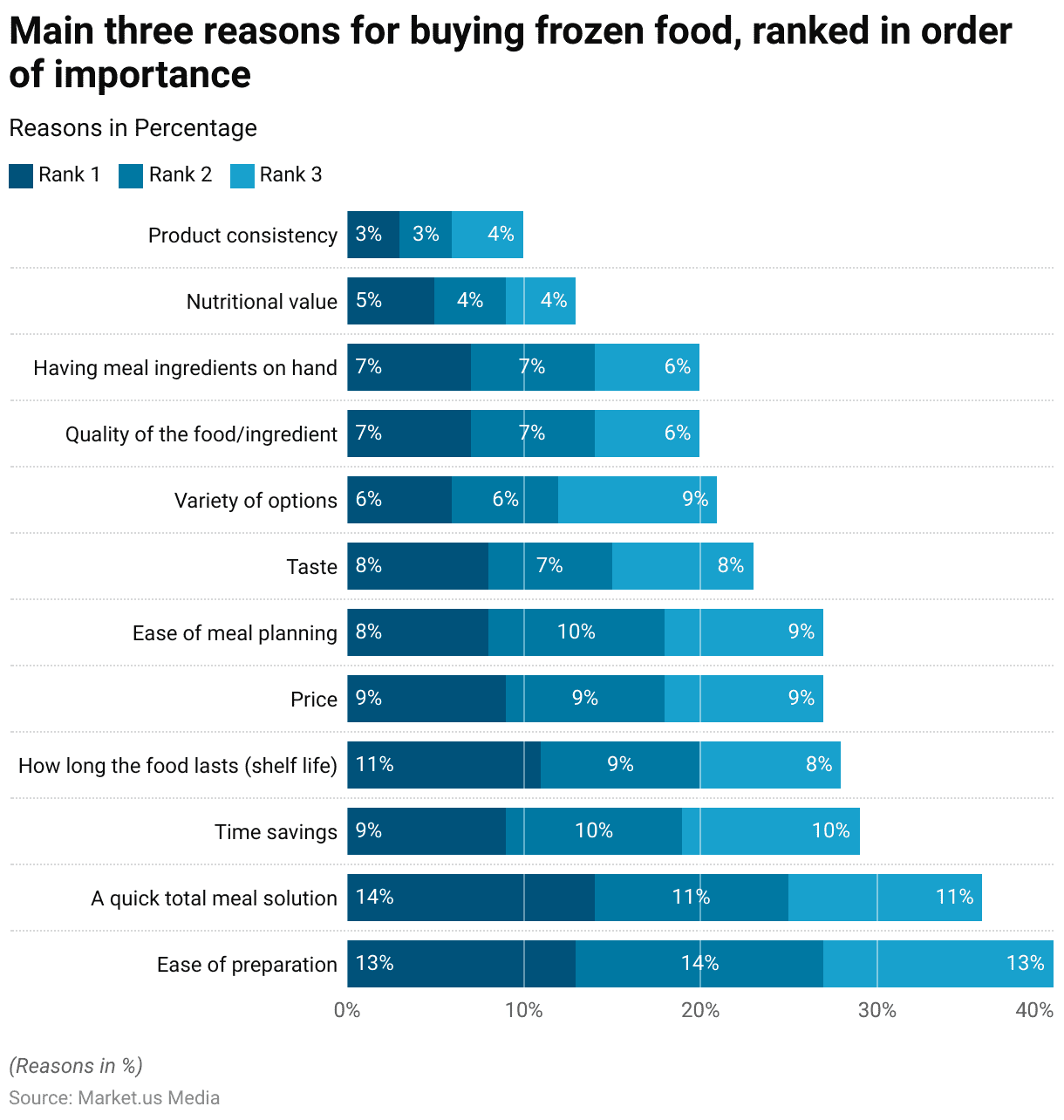
Recent Developments
Acquisitions and Mergers
- FreshRealm Acquisition: FreshRealm acquired the operational assets of meal-kit company Marley Spoon for $24 million, integrating their U.S. operational and supply chain infrastructure.
- McCain Foods Investment: McCain Foods has increased its investment stake in the Ireland-based frozen veggie company Strong Roots, aiming to expand its vegetable-forward frozen products into additional global markets.
- SYSTM Foods Acquisition: SYSTM Foods acquired HUMM Kombucha, adding the Kombucha brand to its portfolio that includes other plant-powered functional beverages.
- Sazerac Acquisition: Sazerac signed a deal to acquire BuzzBallz LLC, a growing ready-to-drink brand portfolio, aiming to strengthen its market presence in this segment.
- Nestlé Divestitures: Nestlé has been active in reshaping its portfolio, selling its La Cocinera frozen business in Spain and divesting its ice cream business in South Africa.
New Product Launches
- Magic Spoon’s Sugar Cookie Cereal: Launched for the holiday season, this cereal offers the taste of sugar cookies but is high in protein and free from sugar and artificial ingredients.
- Catalina Crunch’s Dark Chocolate Cookie Bars: Introduced in Raspberry and Mint flavors, these bars are marketed as low in sugar, gluten-free, grain-free, and keto-friendly.
- Perdue’s Air Fryer Ready Crispy Wings: The first ever wings designed for air frying, available in Roasted, Hot N’ Spicy, and Lemon Pepper flavors. These are made from chicken raised without antibiotics, hormones, or steroids.
Conclusion
Frozen Food Statistics – In conclusion, the frozen food industry demonstrates resilience, adapting to shifting consumer behaviors, notably influenced by the ongoing pandemic.
Convenience, affordability, and variety remain pivotal in driving consumer choices. Manufacturers and retailers can capitalize on these trends by emphasizing easy preparation, quick meals, and time-saving options.
Frozen foods also align with changing shopping habits, minimizing grocery store visits, and addressing safety concerns.
While taste and quality are essential, convenience largely dictates purchases. Moving forward, stakeholders must innovate, address sustainability, and utilize online platforms to meet evolving consumer demands.
Despite challenges, the frozen food sector shows promise for growth and adaptation.
FAQs
Frozen food can be nutritious, especially if it’s minimally processed and free from added sugars, salts, and preservatives. Many frozen fruits and vegetables retain their nutritional value due to quick freezing after harvesting.
Yes, frozen meals are known for their convenience. They require minimal preparation, making them ideal for busy individuals or families looking for quick and easy meal options.
Frozen fruits and vegetables can be just as nutritious as fresh ones, if not more so. They are often frozen at peak ripeness, locking in nutrients, whereas fresh produce may lose some nutrients during transportation and storage.
While frozen food offers convenience and often retains nutrients well, some frozen meals can be high in sodium, saturated fats, or added sugars. Additionally, the texture and flavor of certain foods may change slightly after freezing and thawing.
When handling frozen food, it’s essential to follow proper food safety practices, such as washing hands before and after handling, using separate utensils for raw and cooked foods, and cooking frozen foods to the recommended internal temperature to kill any harmful bacteria.
Discuss your needs with our analyst
Please share your requirements with more details so our analyst can check if they can solve your problem(s)



